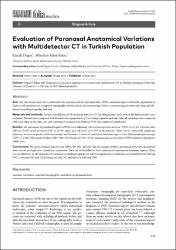Evaluation of Paranasal Anatomical Variations with Multidetector CT in Turkish Population
Citation
Doğan E, Kilinç MR. Evaluation of paranasal anatomical variations with multidetector CT in Turkish population. Folia Med (Plovdiv) 2022;64(3):513-520. doi: 10.3897/folmed.64.e62633.Abstract
Aim: The aim of our study was to determine the prevalence of the paranasal sinus (PNS) variations/aspects of healthy population in Turkey with multidetector computed tomography and to evaluate the relationship of these variations/aspects with each other and difference according to gender and side. Materials and methods: Twenty-four different PNS variations/aspects of 234 healthy patients and a total of 468 bilateral sides were evaluated. Patients were compared with Pearson's chi-squared test (χ2) according to gender and side. Also, all variations were compared with each other in the same way, and correlated variations were found (p<0.05 was considered significant). Results: The prevalence of prominent aspects of PNS are as following: tuberculum septi nasi anterior (TSNA) in 93.6%, ethmoid bulla (EB) in 72.65%, nasal deviation (ND) in 65.4%, agger nasi cell (AG) in 63.25% of the patients. There was no statistically significant difference in terms of gender and between right and left sides. P-values of correlated variations/aspects were: EB/uncinate process type (UPT) 2: 0.001; ND/concha bullosa (CB): 0.03; AG/Onodi cell (OC): 0.04; uncinate process deviation (UPD)/maxillary hypoplasia (MH): 0.04. Conclusions: The most common aspects were TSNA, EB, ND, and AG. The percentages of these anatomical structures mentioned above are far too high to be classified as a variation. They can be described as basic anatomical structures or dominant aspects. There was no difference in the incidence of variations according to gender or side, but significant correlations were found between EB and UPT 2, between ND and CB, between AG and OC, and between MH and UPD.


















